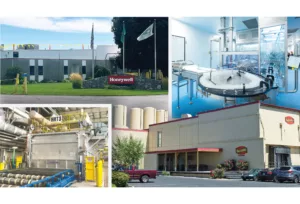Biowall allows school building to filter VOCs naturally
Environmental engineers study physical properties of living part of structure
Just beyond the DNA-like helical staircase in Drexel University's new Papadakis Integrated Sciences Building, the atrium's great showpiece is a vertical wall of living plants, 20 feet wide, rising five stories—or 75 feet—in height.
But the biowall is not just for show. It is an active living filter that removes volatile organic compounds, or VOCs, from the air. Scientists and students at Drexel are studying the biowall and the plant and microbe communities responsible for its air filtration properties to get a better understanding of how it works.
Michael Waring, of the College of Engineering who specializes in indoor environmental engineering, will focus on the chemical and physical aspects of the wall, while two biology faculty members will focus on its biological functions.
Biowalls such as the one at Drexel have been shown to reduce overall concentrations of VOCs, such as benzene, toluene, methyl-ethyl ketone, and formaldehyde, in the indoor air. Biowalls save energy by making it possible to recirculate a larger proportion of cleaner, conditioned air through the building, while bringing in less outdoor air that would require heating or cooling to match indoor conditions.
Drexel's biowall consists of more than 12 different varieties of plants that grow in the absence of soil. The plant roots are embedded between two layers of woven, porous material similar to that of a kitchen scrubbing pad. Water trickles between these layers, providing plant roots with nutrients and hydration.
The water is also key to filtering the air: Fans running behind the wall continuously pull contaminated indoor air through the biowall's porous materials. As a result, VOCs naturally dissolve into the water and become available to bacteria and fungi on the plants' roots. These microbes then consume and break down the VOCs into benign products, primarily carbon dioxide and water. As the microbes remove VOCs from the water, more VOCs can be absorbed from the circulating air, and the cycle continues. According to estimates by NEDLAW Living Walls, the company that designed and installed the biowall, it is capable of generating between 16,000 and 30,000 cubic feet of "virtual" outside air per minute.
While scientists have measured the overall results of this air-filtration mechanism in biowalls, Waring points out that such measurements are coarse—measuring only the total concentration of VOCs in the air before and after passing through a biowall. Researchers don't yet know specifically which chemicals are or are not being filtered out, while few have studied the microbes in plant roots that are responsible for breaking down VOCs. Those are the questions the Drexel team plans to address.
Related Articles



_web.webp?t=1764835652)
